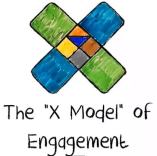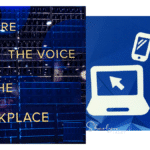We all know what employee engagement means, right? The term is tossed around like salad dressing. There are numerous articles and infographics on the subject. But if someone asked you to describe employee engagement in a single sentence, what would you say?
Mr. Bartender and I were having this discussion recently. So I was really challenged to figure out how to define employee engagement in a single sentence. We talk about it in terms of outcomes like high productivity and better profits. We also like to mention it in relation to enhanced manager – employee communications. Those are all important but it really doesn’t articulate what employee engagement is. Then, thanks to Rory Trotter over at Something Different HR, I think I found it.
Employee engagement lies at intersection of maximum contribution for the business and maximum satisfaction for employees. It’s a sustainable level of high performance that benefits both the company and the employee.
Okay, it’s two sentences. But it works. Kudos to BlessingWhite and this video titled, “The ‘X’ Model of Employee Engagement”. They do a very nice job of explaining engagement in a succinct manner.
https://youtu.be/66vXiCFbKBI
Sometimes I wonder if the reason companies are having so much difficulty with employee engagement is because they are operating with a vague definition. They know it’s important but can’t get their arms around it. The first step to solving any challenge is being able to define it.
What do you think of this definition? Share your thoughts in the comments.








Vicki Hess says
Sharlyn,
I couldn’t agree with you more. When I work with healthcare organizations on optimizing employee engagement we talk about a few ideas related to this. 1) no one wakes up in the morning and says “I can’t wait to be engaged at work”. 2) too many times, employee engagement is couched in the customer and organizational benefits category – leaving the employee out of the equation. 3) we (leaders and staff) need a shared vocabulary for engagement.
My one sentence definition. Employee engagement is when employees are satisfied, energized & productive. I call it Professional Paradise (from my first book, SHIFT to Professional Paradise). People who are highly engaged at work are Chief Paradise Officers.
Another key element of engagement is included in my upcoming book, 6 Shortcuts to Employee Engagement. The idea here is that “It Takes 3” to create engagement. 1) The organization at a strategic level; 2) the leaders at a tactical level; and 3) the employee at a personal level. But that’s a whole other blog post and comment.
Have a great day in Professional Paradise!
Catie Farrow says
Sharlyn & Vicki – these are both wonderful insights into the mysterious ideal known as “employee engagement.” Not being able to truly define what employee engagement is is certainly a roadblock to success, and organizations should seek to define this term before diving in.
Vicki – I couldn’t agree more that all levels of the organization are responsible for elevating employee engagement. At my company, we call that the “Trifecta of Engagement.”
Thanks ladies!
Jen @ Daycare In Demand says
I love Vicki’s definition: satisfied, energized, and productive! I think this nicely sums up the concept of “employee engagement” in a nutshell. (It’s also clear that disengaged employees are just the opposite: dissatisfied, with low energy and low productivity.)
Betty McHale says
Love the description and the comments. I too, think employee engagement is tossed around alot by organizations who don’t understand employees are engaged when management set clear expectations, provide frequent feedback, provide an understanding of accountability and reward or recognize good performance. When management is engaged, the employee becomes engaged. In addition, providing challenging work assignments, holding stimulating conversations with your work group, and teaching “systems” thinking are techniques that will engage employees. When these elements are present, then there is an intersection where both the employee and his/her manager meet and both are engaged and satisfied.
Sharlyn Lauby says
Thanks everyone for the great discussion. It’s nice to know that I’m not the only one looking for a clear, concise definition! Awesome input.
Rory C. Trotter Jr says
Fantastic post as always, Sharlyn.
At its core, employee engagement is about generating buy-in. Every employee is at a different place in this continuum (and has different motivations), so tapping into what makes each employee tick is ultimately about rewarding results.
Often, organizations establish a “culture” (which is really just a way of doing things) and lose sight of the fact that cultural values aren’t always in line with what is best for the organization.
A company who can be fluid in this respect will always have an engaged employee population.
Thanks a *lot* for sharing Sharlyn, and as always keep writing.
Best,
Rory
Kenny Pattie says
HI Sharlyn,
Great article, thanks for this. Just to add to some of the (also very interesting) comments above, I think that it’s important to also consider values and culture within an organisation. In order to maximise engagement within a company, it is imperative that all employees are bought into the company’s values, and moreover the culture is one of openness and transparency, where different views are respected.
In short, there’s no easy way to sum up ‘engagement’ in one sentence, but I fully applaud your efforts in getting there!!
Marie Wallace says
I really like the way this video describes engagement and would agree that its a great definition, however…
I’m a data scientist and have been investigating ways that we can apply analytics to provide engagement measurements – data to support management in understanding, at a microscopic level, how people are engaging across the organization. In order to do this we need a much more precise definition of engagement that is specific to roles, jobs, organizations, industries, etc.
What I would LOVE LOVE LOVE :-)) as a data scientist would be to see a close partnership with organizational specialists in translating these broader engagement definitions into more precise specifications.
With all the great interactional data that is being gathered across organizations (even more so now with enterprise social platforms) it would be a shame not to be able to use this data to help us create more productive and happy environments within which to work.
I wrote a short post about this on my own blog this week if you are interested: allthingsanalytics.com
Sharlyn Lauby says
Thanks for the comments! I noticed a lot of conversation about buy-in. And we all buy into things differently – some with data and others with emotion or connection. If we’re trying to engage someone, we need to do it on their level, not on ours.
Fraser Marlow says
To Mary Wallace et al. – you can find the research (actually an ongoing research series) that explains this model in detail at http://www.blessingwhite.com/EE2013 and for those interested in the engagement strategies based on the work that led up to this model, there is a book called ‘the engagement equation’ published by Wiley. I hope this helps!
Peter Cook says
You may well enjoy the chapter on engagement in the book Punk Rock People Management, available via http://www/academy-of-rock.co.uk-punk-rock-HR
Marie Wallace says
Thanks for the pointer Fraser, your video rocked 🙂
Snizhana says
Hi Sharlyn,
Great article. Hope you don’t mind me sharing it on LinkedIn.
Shep Hyken says
Nice definition of employee engagement – short, simple and accurate. And, great video to support the definition. The start of employee engagement is at the hiring process; getting the right people. Once you have good people, they must be aligned with your definition of success. Once they create or experience that success, they should be recognized and appreciated. That is what starts and continues the employee engagement process.
Patti Fiette says
Vicki’s quote, “Employee engagement is when employees are satisfied, energized & productive.” and the comment about breaking that down into specifics also reflects on the comment about ‘Each employee is somewhere on a spectrum’, even if we were to breakdown those specifics. One might be the culture issue.
Example: I work for IBM. It’s culture is based around high ethical standards and ‘respect for the employee’. Is this good for the company? Yes. Does it lead to higher revenues? Maybe… Does it lend itself to engaged employees? Yes, because somewhere on that engagement ‘spectrum’ has to be questions about fairness, respect, good communication, compatible values. So culture has something to do with employee engagement. In my case, the IBM culture registers on my spectrum of being engaged. But other factors motivate me and lead to that ‘satisfied, energized, productive’ score. I want to feel as if my work makes a difference, that it moves the company ball forward – that is why I like sales and marketing. For myself and others, it will be a host of many factors…happy to participate in that discussion…it may have already been done by HR professional organizations in a formal way.
Theo says
Great post Sharlyn. In a similar vein, a diagram on the difference between engagement, motivation, and satisfaction …
http://www.dtssydney.com/blog/employee_engagement_research_summary
Patti Fiette says
Thank you for this link, I like seeing the study results of engagement/satisfaction and business results, which might be difficult to prove, but makes sense.
Beth Miller says
I think the key word in your definition is sustainability. Most employees are engaged from time to time but keeping engagement high on an ongoing basis is where companies reap productivity and profits. The most important component to employee engagement being sustainable is having leaders who promote engagement with their employees. It starts with leadership!